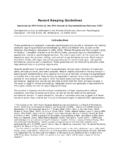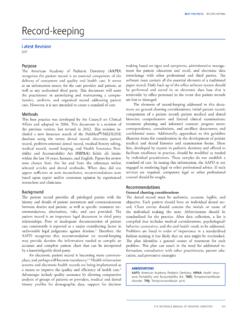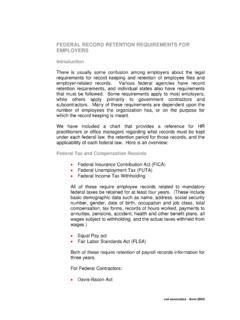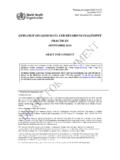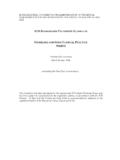Transcription of Guideline 6B: Record Keeping and Client Identification for ...
1 Guideline 6B: Record Keeping and Client Identification for real estate Rev. 2016-06 Guideline 6B: Record Keeping and Client Identification for real estate July 2016 This replaces the previous version of Guideline 6B: Record Keeping and Client Identification for real estate Brokers or Sales Representatives issued in February 2014. The changes made are indicated by a side bar to the right of the modified text in the PDF version. Table of Contents 1 General .. 4 2 Record Keeping and Client Identification Obligations .. 7 real estate brokers or sales representatives .. 7 real estate developers .. 8 Keeping personal information .. 9 3 Records To Be Kept .. 10 General exceptions to Record Keeping .. 10 Large cash transaction records .. 11 Receipt of funds records .. 12 Client information records.
2 14 Suspicious transaction report records .. 15 Identification information on all records .. 15 Records regarding unrepresented parties for real estate brokers and sales representatives .. 16 4 Client Identity .. 16 When and how do you have to ascertain Client identity? .. 16 General exceptions to Client 17 Client identity for large cash transactions .. 18 Client identity for suspicious transactions .. 18 Client identity for other records .. 18 How to ascertain the identity of an individual .. 19 Client identity for corporations and other entities .. 22 Keeping Client Identification information up to date .. 24 5 Ongoing Monitoring of Business Relationship and Related Records .. 24 Business relationship Record .. 27 6 Third Party Determination and Related Records .. 28 Third party determination.
3 28 2 Third party records .. 29 7 How Should Records Be Kept? .. 30 8 Penalties for Non-Compliance .. 31 9 Comments? .. 31 10 How to Contact FINTRAC .. 31 Glossary of Terms .. 32 3 1 General The objective of the Proceeds of Crime (Money Laundering) and Terrorist Financing Act is to help detect and deter money laundering and the financing of terrorist activities. It is also to facilitate investigations and prosecutions of money laundering and terrorist activity financing offences. This includes reporting, Record Keeping , Client Identification and compliance regime requirements for real estate brokers or real estate sales representatives and real estate developers. A glossary is included in Appendix 1 to help you understand the most common terms used throughout this Guideline . A real estate broker or real estate sales representative means an individual or an entity that is registered or licensed in a province to sell or purchase real estate .
4 If you are a real estate broker or real estate sales representative, you are subject to the obligations explained in this Guideline when you act as an agent regarding the purchase or sale of real estate . This includes the buying or selling of land, houses, commercial buildings, etc. Such activities trigger these obligations whether or not you get a commission for the real estate transaction and whether or not you have fiduciary duties regarding it. These obligations do not apply to you for activities related to property management. This means that if you only deal in property management transactions, such as leases or rental management, not purchases or sales, the obligations explained in this Guideline do not apply to you. A real estate developer means an individual or an entity other than a real estate broker or sales representative, who in any calendar year after 2007 has sold the following to the public: at least five new houses or condominium units; at least one new commercial or industrial building; at least one new multi-unit residential building each of which contains five or more residential units; or at least two new multi-unit residential buildings that together contain five or more residential units.
5 In the context of real estate developers, sales to the public include those to an individual, a corporation or any other type of entity. Sales to be public exclude those between affiliates and those between a subsidiary and its owner. Also in this context, a new house or other building is one that was constructed within the past two years and was not occupied for its intended purpose before being sold. For example, a home occupied by a developer as a sales office would still qualify as a new home, as long as it is sold within two years of being built. 4 From the day you first meet any of these conditions regarding your sales, you will be considered a real estate developer for the rest of that year. You will also be considered a real estate developer in following years, regardless of whether you meet any of the conditions in those following years.
6 In other words, once you are considered a real estate developer, you will remain as such from that day forward, until there is a substantial and permanent change to your operations. If you are a real estate developer as defined above, you are subject to the obligations explained in this Guideline when you engage in activities relating to the sale of any of the following to the public: a new house; a new condominium unit; a new commercial or industrial building; or a new multi-unit residential building. Also, if you are a real estate developer that is a corporation, you are subject to these obligations whether you sell those buildings on your own behalf or on behalf of a subsidiary or affiliate. In this context, an entity is affiliated with another entity if one of them is wholly-owned by the other, both are wholly-owned by the same entity or their financial statements are consolidated.
7 If you engage a real estate broker or sales representative to act as your agent for your sales to the public, the obligations explained in this Guideline do not apply to you. In this case, the real estate broker or sales representative would be responsible for meeting these obligations. However, if the real estate broker or sales representative is your employee, you remain responsible for meeting these obligations. If you are a real estate broker or sales representative or a real estate developer, this Guideline has been prepared to help you meet your Record Keeping and Client Identification obligations. This Guideline uses plain language to explain the most common situations under the Proceeds of Crime (Money Laundering) and Terrorist Financing Act as well as the related Regulations. It is provided as general information only.
8 It is not legal advice, and is not intended to replace the Act and Regulations. Record Keeping and Client Identification obligations for other types of reporting entities are explained by sector in other versions of this Guideline (accountants; financial entities; securities dealers; life insurance companies, brokers and agents; money services businesses; agents of the Crown that sell or redeem money orders; casinos; dealers in precious metals and stones; and British Columbia notaries). 5 For more information about money laundering and terrorist financing, or other requirements under the Act and Regulations applicable to you, see the guidelines in this series: Guideline 1: Backgrounder explains money laundering, terrorist financing, and their international nature. It also provides an outline of the legislative requirements as well as an overview of FINTRAC s mandate and responsibilities.
9 Guideline 2: Suspicious Transactions explains how to report a suspicious transaction. It also provides guidance on how to identify a suspicious transaction, including general and industry-specific indicators that may help when conducting or evaluating transactions. Guideline 3: Submitting Suspicious Transaction Reports to FINTRAC explains when and how to submit suspicious transaction reports. There are two different versions of Guideline 3, by reporting method. Guideline 4: Implementation of a Compliance Regime explains the requirement for reporting entities to implement a regime to ensure compliance with their obligations under the Proceeds of Crime (Money Laundering) and Terrorist Financing Act and associated Regulations. Guideline 5: Submitting Terrorist Property Reports to FINTRAC explains when and how to submit terrorist property reports.
10 Guideline 6: Record Keeping and Client Identification explains the requirement for reporting entities to ascertain the identity of their clients and keep records. There are several different versions of Guideline 6, with each one applicable to a particular sector. Guideline 7: Submitting Large Cash Transaction Reports to FINTRAC explains when and how to submit large cash transaction reports. There are two different versions of Guideline 7, by reporting method. Guideline 8: Submitting Electronic Funds Transfer Reports to FINTRAC explains when and how to submit electronic funds transfer reports. There are three different versions of Guideline 8, by type of electronic funds transfer and reporting method. Guideline 9: Submitting Alternative to Large Cash Transaction Reports to FINTRAC explains when and how financial entities can choose the alternative to large cash transaction reports.
